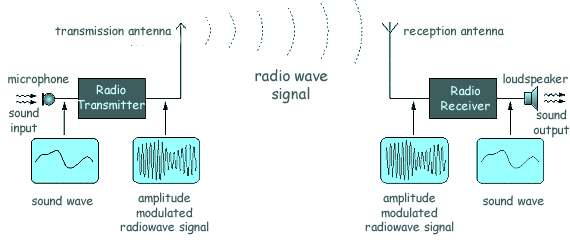Radio and TV waves These are the longest wavelength, lowest frequency part of the electromagnetic spectrum family. They are used for communications. Analogue radiowave signals have been replaced by digital ones since the dominance of computerised commpunication. When radiowaves are absorbed by an aerial the electrons in the aerial vibrate at the same frequency as the radiowaves. This gives rise to an alternating voltage (current) -
Radio systems used for communications will have the following elements: TransmitterEach system contains a transmitter. This consists of a source of electrical energy, producing alternating current of a desired frequency of oscillation. The transmitter contains a system to modulate (change) some property of the energy produced to 'print' a signal on it. This modulation might be as simple as turning the energy on and off, or altering more subtle properties such as amplitude, frequency, phase, or combinations of these properties. AntennaThe transmitter sends the modulated electrical energy to a tuned resonant antenna; this structure converts the rapidly-changing alternating current into an electromagnetic wave that can move through free space (sometimes with a particular polarisation). Electromagnetic waves travel through space either directly, or have their path altered by reflection, refraction or diffraction. The intensity of the waves diminishes due to geometric dispersion (the inverse-square law); some energy may also be absorbed by the intervening medium in some cases. Noise InterferrenceNoise will generally alter the desired signal; this electromagnetic interference comes from natural sources, as well as from artificial sources such as other transmitters and accidental radiators. Noise is also produced at every step due to the inherent properties of the devices used. If the magnitude of the noise is large enough, the desired signal will no longer be discernible; this is the fundamental limit to the range of radio communications. Receiving antennaThe electromagnetic wave is intercepted by a tuned receiving antenna; this structure captures some of the energy of the wave and returns it to the form of oscillating electrical currents. At the receiver, these currents are demodulated, which is conversion to a usable signal form by a detector sub-system. The receiver is "tuned" to respond preferentially to the desired signals, and reject undesired signals. Radio CommunicationsEarly radio systems relied entirely on the energy collected by an antenna to produce signals for the operator. Radio became more useful after the invention of electronic devices such as the vacuum tube and later the transistor, which made it possible to amplify weak signals. Today radio systems are used for applications from walkie-talkie children's toys to the control of space vehicles, as well as for broadcasting, and many other applications. Here is a viclip of a 1948 film that shows how a TV camera works. Although today's cameras work with more sophisticated electronics the basic process is the same.
|
Follow me...
|






